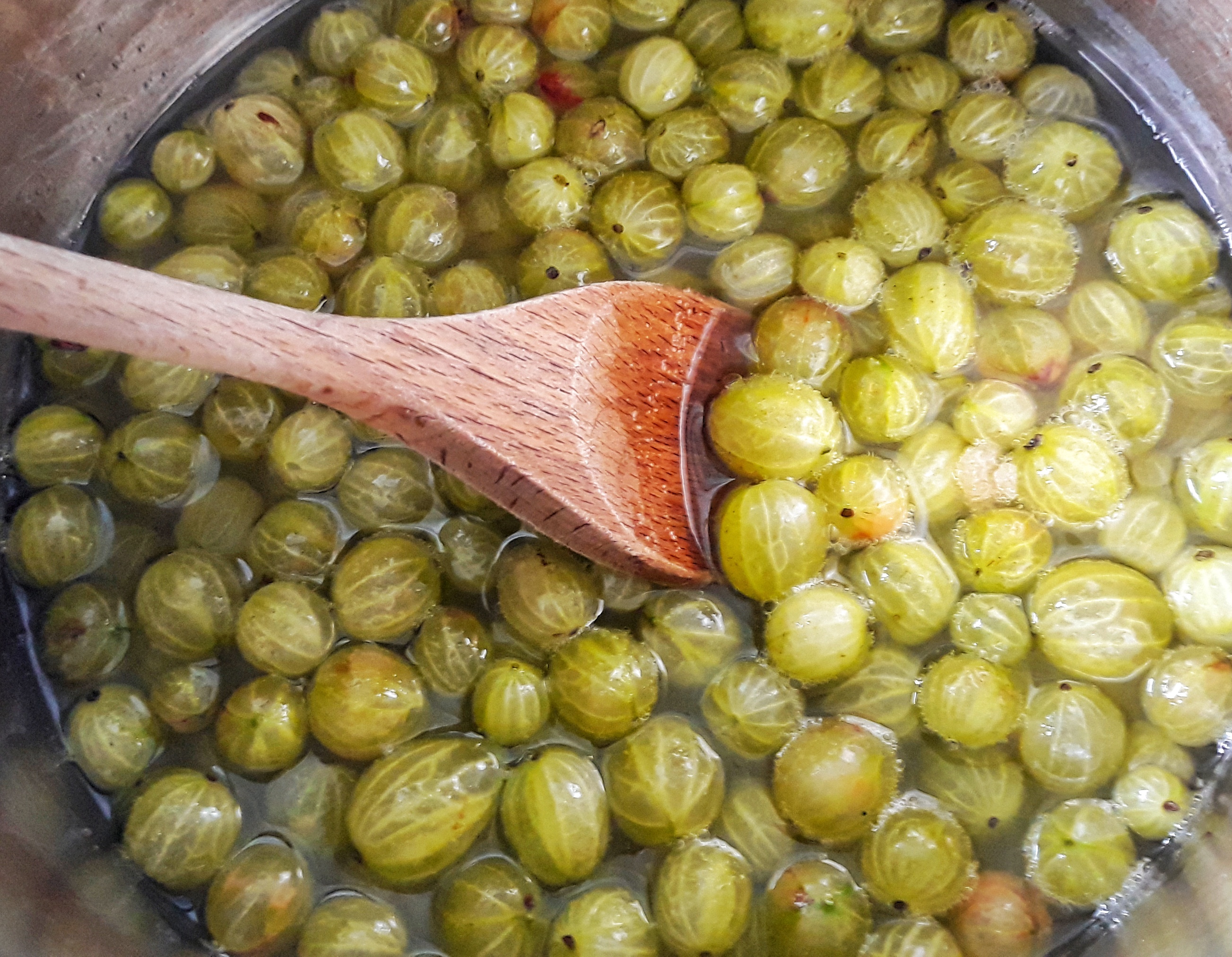
If you like the blogs and podcast I produce, please consider treating me to a virtual coffee or pint, or even a £3 monthly subscription: follow this link for more information.
I was kindly given part of a large crop of gooseberries by my friends Kit and Ellie, their two bushes have been prolific this year. Earlier in the summer, I used some of their underripe berries to make a sauce to accompany mackerel, but now they were large and quite sweet.
I made the lion’s share of them into gooseberry jam and thought I would give you a recipe, as it is so easy to make, and you are unlikely to find it in the shops. If you don’t know of any gooseberry bushes, try a greengrocer – I have spotted them in quite a few shops this year.
The great thing about gooseberry jam is that the gooseberries change in colour, adopting an appetising warm pinkish hue with the intense heat of jam-making. This change is apparently due to the anthocyanins in the gooseberries interacting with metal ions leached from the cooking vessel itself.
Gooseberries are not as juicy as their red, white and blackcurrant relatives so they need a bit of extra added water to help dissolve the sugar. Gooseberries are high in pectin, especially when young, so there should be enough to set the jam. However, if they are late season and ripe, you might want to replace a small proportion of the sugar with jam sugar, which contains pectin, to give them a helping hand.
The jam I made is simple: gooseberries, sugar and water, but if you have any of the extras in the ingredients list below, feel free to add them if you like.
The jam makes a great roly-poly or Victoria sponge filling.
The quantities below makes around 1 litre of jam, and it is easy to scale up or down depending upon the amount of gooseberries you have to hand.
1 kg gooseberries, washed, topped and tailed
1 kg granulated sugar (or 800 g granulated and 200 g jam sugar, if the gooseberries are ripe
500 ml water
Optional extras: A dozen elderflower heads wrapped in muslin, a good bunch of sweet cicely tied with twine or replace 250 ml of the water with Muscat wine.
Before you start, place a saucer in the freezer.
Place all the ingredients in a large, heavy based saucepan on a medium heat.

Stir occasionally and when all of the sugar has dissolved, turn the heat up to bring the gooseberries to a really good boil. After around 15 minutes – by now they should have a pinkish tinge about them – test to see if you have got a set. Either take the jam’s temperature with a temperature probe and see if it is 105°C, or take a teaspoon of the mixture and place a few drops on your very cold saucer you had stored in the fridge, let it cool for a minute and see if the drops wrinkle when you push them with a finger.
You can use a candy thermometer instead of a probe, but I find them imprecise. However, if you have a trusty one, by all means slot it down the inside of jam before you start to boil it.
Leave the jam to cool for 15 minutes and skim any scum with a large spoon or ladle.

Have some sterilised jars ready and ladle in the jam. A jam funnel is helpful here. Alternatively, pour the jam into a Pyrex or stainless-steel jug rinsed out with scalding water and carefully fill your jars. Seal when still very hot.
I have written at length about setting points and sterilisation, so if you are unsure, have a look at this post here for a walk-through.

Excellent!
LikeLiked by 1 person
Thanks again for your posts, if it helps anyone in the US I’ve found gooseberries in the frozen section of Indian grocery stores, best regards!
LikeLiked by 1 person
Indian stores!? How odd! I wonder if gooseberry bushes were planted during the days of the British Raj…..
LikeLike
Very late to this, but Indian gooseberries are an unrelated, but similar looking fruit. So those will not provide the same result
LikeLiked by 1 person
It’s never too late to comment on this blog! I’ll have to keep a look out nevertheless. I bet they taste great. Thanks for the info.
LikeLike
I’m accustomed to processing raspberry jam (boiling the pre-sterilized, filled, topped jars for 10 minutes) before leaving the jars at room temperature. Does this recipe keep OK at room temperature without processing the filled jars? Thanks.
LikeLike
I always sterilise my jars by putting them in a oven set to 120oC for 25 minutes so I don’t know! It’ll probably be fine, but then again, I’ve never tried it! Sorry, cant be much hep for you there.
LikeLike